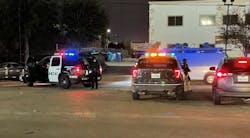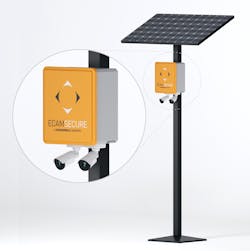Some security experts see a future world where private security officers and public police give up their “turf issues” and forge a closer relationship in the U.S. to protect people and property.
Currently the state of relations between public and provide officers runs the gamut, from proactive and established relationships and communication protocols to little or no cooperation at all, says Steve Amitay, executive director of the National Association of Security Companies (NASCO).
But he sees cooperation becoming a necessity in the future so public police officers can focus on core policing duties and keep communities safe. There are some examples of this happening already.
Recognizing a gap exists between law enforcement and the communities they serve, the Orange County (Fla.) Sheriff’s Office (OCSO) and the University of Central Florida launched a pilot program in 2016, the Orange County Public and Private Security Partnership.
The program was meant to help supplement law enforcement with private security to reduce crime and the fear of crime, and to augment community services in target areas through identity code enforcement violations, high visibility patrols and victim and citizen checks. The private security firm selected to participate was G4S, which was acquired in 2021 by Allied Universal.
Community Presence
Meant to last for a minimum of 90 days, or until funding ran out, the pilot program focused primarily on community relations and engagement, crime follow-up and victim services, crime prevention knowledge, building a high visibility presence and monitoring properties.
Additionally, G4S provided a community presence through patrolling. Officers documented and reported citizen contacts, crimes in progress, blighted properties, defective streetlights and suspicious persons or vehicles to the sheriff’s office.
A 40-hour OSCO orientation and training program equipped the private security officers with the knowledge of when to utilize their radios, when to contact non-emergency numbers, what to report to an on-duty deputy or Orange County 311, and what to document. This training program also offered ride-along trips with public police.
The city of Orlando, Fla. implemented this program in two of its high-crime areas, Azalea Park and Holden Heights.
A pre-program survey confirmed that 60% of the respondents lived in Azalea Park, the more organized of the two communities. Four critical questions were asked: how patrols impacted the community’s image of law enforcement, how private security patrols impacted citizen’s perception of crime, fear, and disorder, what the impact of private security patrols was, and the perception of private security patrols by sheriff’s office personnel.
The first question was answered positively. Post-test respondents scored higher in the following categories:
Police are Good People
- Pre-test Average: 3.9
- Post-Test Average: 4.14
Police Care About Me and My Family
- Pre-test Average: 3.63
- Post-Test Average: 3.9
Police are Trustworthy
- Pre-test Average: 3.65
- Post-Test Average: 3.98
Police Treat Everyone with Dignity and Respect
- Pre-test Average: 3.4
- Post-Test Average: 3.68
Police Cars are Visible in Communities
- Pre-test Average: 4.32
- Post-Test Average: 4.95
Citizens’ perceptions of the amount of crime in Azalea Park and Holden Heights differed from pre-test results, answering the second research question. The fear of being assaulted with a weapon in their neighborhood jumped, however, likely due to Pulse nightclub shooting:
Amount of Crime Changed
- Pre-test: 3.49
- Post-test: 2.79
Fear of Attack in Neighborhood w/ Weapon:
- Pre-test: 5.66
- Post-test: 6.18
The results of the third question were mixed, with Azalea Park and Holden Heights diverging down two different paths. Azalea Park saw minor increases in homicide, robbery, sex crimes, and auto theft, while residential burglary, commercial burglary, and auto burglary decreased significantly:
Residential Burglary
- 2014: 24
- 2016: 16
Commercial Burglary
- 2014: 10
- 2016: 1
Auto Burglary
- 2014: 23
- 2016: 13
Holden Heights saw significant decreases to residential and commercial burglaries:
Residential Burglary
- 2014: 36
- 2016: 29
Commercial Burglary
- 2014:19
- 2016: 8
However, auto burglaries in Holden Heights spiked:
Auto Burglary
- 2014: 12
- 2016: 23
Part II offenses, including felony drugs, misdemeanor drugs and other sex offenses were somewhat mixed, with Holden Heights seeing a notable decrease in every field:
Felony Drugs
- 2014: 49
- 2016: 33
Misdemeanor Drugs
- 2014: 21
- 2016: 12
Other Sex Offenses:
- 2014: 36
- 2016: 12
Felony drug and misdemeanor drug offenses increased in Azalea Park, however, though their reports of other sex offense crimes dropped to zero:
Felony Drugs
- 2014: 2
- 2016: 10
Misdemeanor Drugs
- 2014: 4
- 2016: 9
Other Sex Offenses
- 2014: 2
- 2016: 0
The sheriff’s office personnel answering the fourth question largely did not believe in the project and felt it set a dangerous precedent. They on average did not feel the program should be expanded or continued, that it made residents safer, or that it was a worthy use of public funds.
The overall results, however, appear to disagree with this assessment. The patrols increased police visibility based on community need and culture, saw a reduction in the perceived amount of crime over three months, and significantly increased the public’s perception of law enforcement, the study concluded.
While the actual crime statistics showed a small, but positive change in crimes committed, the bulk of the program’s potency largely came from the perception of the city’s residents, who stated that it was “exactly what they needed.”
Stopping Organized Theft
Another recent example of a public-private law enforcement partnership occurred in Los Angeles, not long after the city made national and international news in 2021 through shocking images of criminal disruption.
Trains that paused along the sidetracks to allow for the assemblage had become easy targets for theft. Images flooded the news and social networks of ransacked train cars, with discarded goods and abandoned packaging crowding the tracks.
With the COVID-19 pandemic already roiling supply chains, the thefts further compromised them. A multi-agency Train Burglary Taskforce, spearheaded by the Los Angeles Police Department’s Commercial Crimes Division was charged with breaking up the theft ring and restoring order.
LAPD Det. Joseph Chavez and Officer Mark Sternin were among the team assigned to the case. Previous investigations had identified a nearby parking area where the thieves would coordinate their attacks, then return to sort out the stolen goods.
The lot, however, was small and cramped, making undetected surveillance difficult or impossible. The team didn’t want law enforcement officers exposed to unnecessary risk – they needed to be see without being seen.
Chavez and Sternin visited Long Beach-based ECAMSECURE, a subsidiary of GardaWorld that provides mobile, trailer-based camera platforms and remote command centers to deter crime in at retail, construction, warehousing and other types of businesses, as well as law enforcement.
LAPD and ECAMSECURE designed a surveillance package of free-standing mobile surveillance unit and monitoring software that would be undetected by the suspects yet capable of close, flexible observation.
Direct Communication
The cameras were equipped with both night vision and pan-and-zoom capabilities, increasing their ability to observe criminal behavior. By design, the video feed did not go to a monitoring center but directly to ECAMSECURE’s software, which sent alerts to the officers via secure web connections available on desktops, laptops and phones.
“We could operate the pan and zoom cameras ourselves, through our devices,” Sternin said in a case study published about the partnership. “The cameras reacted very quickly to our controls, and there was almost no lag time.”
“We were looking for clues to take us to the next step,” Chavez said in the case study. “We knew they were doing bigger things, and we were looking for the main storage location.”
Through consistent camera surveillance, LAPD identified most of the members of two criminal crews. In 2021, the Train Burglary Taskforce got its big break when the cameras revealed suspects loading stolen train property into a vehicle.
Investigators then tracked the vehicle to its destination: the warehouse of stolen goods.
“We followed the vehicle into the [warehouse] area, arrested the occupants, then arrested people at the facility,” Chavez said.
Overall, five suspects were apprehended and about $20 million in stolen goods – including e-bikes, computers and laptops – were recovered.
About the authors: John Dobberstein is the managing editor of SecurityInfoWatch.com and Samantha Schober is the associate editor of SecurityInfoWatch.com.








